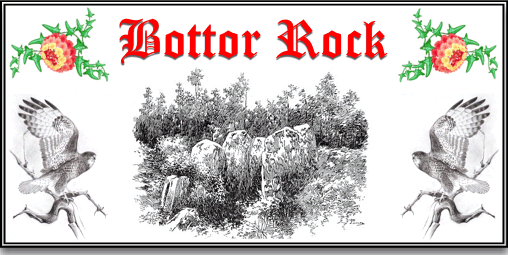
Amongst other claims to fame the small rock pile called Bottor Rock is arguably the most eastern of Dartmoor tors. The small pile can be found just south-west of the tiny village of Hennock and stands at a height of 793 feet. If you read most of the topographical Dartmoor books you will find barely a mention of Bottor rock but by compiling all the snippets, ancient traditions and legends slowly emerge.
The first documentary record of the tor comes from the assize rolls of 1238 where it is written as Bodetorre, the place-name is thought to have meant, Botta’s or Boda’s torr. There is a suggestion that the origins of name means inhabited hill and whilst the name does indicate that the hill/tor was owned by Botta or Boda it is hard to establish whether he actually lived on it. Further documentary records show the name mutate thus:
Bottetorre – 1306 (assize rolls)
Bottorre – 1330 (lay subsidy rolls)
Westbottorre – 1414 (feet of fines)
One of the earliest examples of Bottor appearing on a map was from Donn’s Map of Devon which was dated 1765 as depicted below:
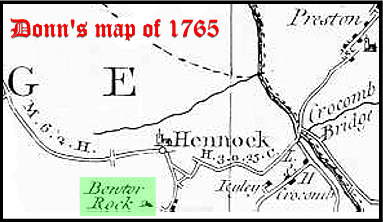
A recent book on Hennock states there is a possibility that during prehistoric times people lived below the tor as there have been flint finds in the area of nearby Standwick. Around 200 pieces of loose flint were also discovered at Warmhill along with some Roman pottery. It also considers that at Bottor Rock Farm there were two concentric stones circles and that these were shown on the Tithe map of 1840 and were destroyed in 1842. However, the English Heritage National Monument Register lists four prehistoric features and finds:
1) ADS Record ID – NMR_NATINV-447302 –“Possible Bronze Age Round Barrow”.
2) ADS Record ID – NMR_NATINV-447364 – “Supposed ‘Idol or Stone Altar’, not certainly located but probably a natural feature”.
3) ADS Record ID – NMR_NATINV-447367 – “Supposed stone circles, probably Bronze Age/Iron Age enclosed hut circle settlement”.
4) ADS Record ID – NMR_NATINV-899624 – “Neolithic flint scatter”.
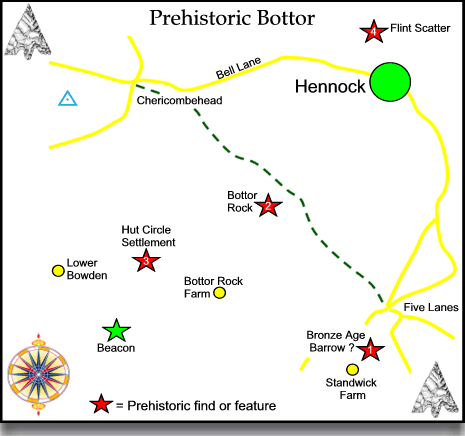
Crossing, 1990, p.301, also comments on the hut circle settlement when he observes: “Quite close to Bot Tor farmhouse, just below, is a field called Brady Park, in which an interesting object once existed. It consisted of a small pound, 77 feet in diameter, with a wall about 3 feet high and 4 feet thick“. Either way there was certainly people in the vicinity of Bottor from Neolithic times and living below the rock during the Bronze/Iron age. If the 19th century antiquarians are to be believed then around the Iron Age there were Druids using Bottor for their rituals. Fraser, 2004, p.7, cites a comment from one such antiquarian called Davidson: “from its peculiar appearance and the Druidical relics immediately below it, is supposed to have been an object of worship as a rock idol”. When describing the rock pile Crossing, p.301, notes, “… From this fine pile, the upper mass of which is sometimes referred to as Bottor’s Nose ...”. This comment infers that the rock pile had been regarded as representing some form of human face, hence the ‘nose’.
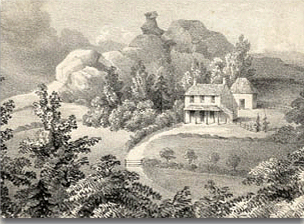
Bottor Cottages and Rock
Another slight confusion concerning Bottor arises with a comment made by Sabine Bearing Gould, 1911, p.72 when he comments: “In the crevices of Bottor Rock in Hennock, Devon, John Cann, a Royalist, found refuge…”. Although there is some debate as to where exactly John Cann hid the general consensus of opinion is that ‘John Cann’s Rocks’ are in the nearby Furzeleigh Woods.
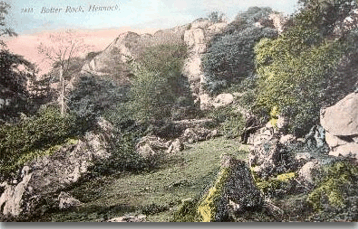
Bottor Rock – An Early Postcard
Lastly, Bottor Rock was or is depending on ones beliefs the haunt of piskies and legend tells of local folk often hearing them singing when passing the rock at night. Crossing, p. 301, clearly states: “The hollows in the base of Bot Tor Rock were formerly the haunt of the pixies, who have often been heard singing by the good folk of Hennock“.
Bibliography.
Baring Gould, S. 1911 Cliff Castles and Cave Dwellings of Europe, Seeley, London.
Crossing, W. 1990 Crossing’s Guide to Dartmoor, Peninsula Press, Newton Abbot.
Fraser, I. 2004 Hennock – A Village History, Sylverwood Publishing, Newton Abbot.
 Legendary Dartmoor The many aspects past and present of Dartmoor
Legendary Dartmoor The many aspects past and present of Dartmoor

Thank you for the very interesting site! Please can you tell me the source of the ‘Bottor Cottages and rock’ drawing? I am doing some research into the property for a university paper.
Thank you.